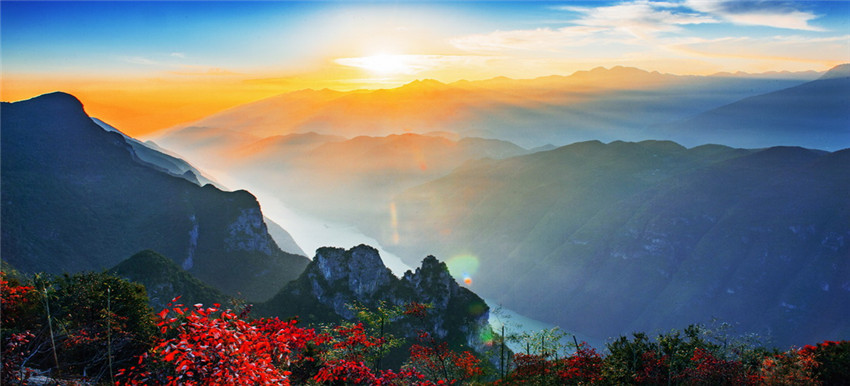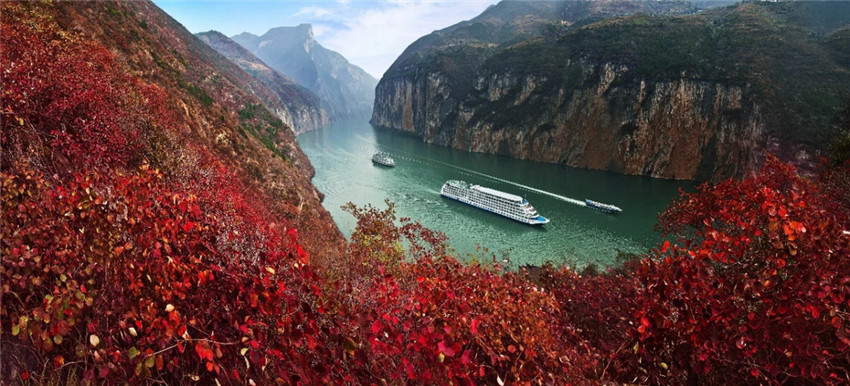A Brief Introduction to Chongqing
重庆简介

重庆是中国西部最大的工商业中心,素有“江城”、“山城”之美誉。重庆的山、水、夜景、火锅都令旅游者们心驰神往。重庆是一座有3000多年历史的文化名城。1997年之前,重庆辖属于四川省,1997年6月18日,被正式批准设立直辖市。在中国的四个直辖市(北京、天津、上海、重庆)中,重庆市面积最大,人口最多。重庆市下辖43个区县,全市幅员面积8.24万平方公里, 为北京、天津、上海三市总面积的2.39倍。至2016年全市总人口为3199万人,为北京、天津、上海三市总人口的83%。重庆市居于层峦叠嶂之中,地形起伏有致,立体感强。市区坐落在长江与嘉陵江交汇处,四面环山,江水回绕,城市傍水依山,层叠而上,既以江城著称,又以山城扬名。然而最具特色的,还要数山城的夜色。凭高眺远,万家灯火起伏错落,银霞明灭,与两江粼粼的波光、满天闪烁的星斗交相辉映,其景奇丽醉人。重庆市内有包括大足石刻和长江三峡在内的许多著名旅游景点。大足石刻始建于公元7世纪,由一系列的人像和雕塑组成,共同集释了中国道教、佛教、儒教“三教”造像之大成。1999年被联合国教科文组织列为世界文化遗产,摩崖造像多达75处,雕像5万余身,铭文10万余字。长江三峡风景区是瞿塘峡、巫峡和西陵峡三段峡谷的总称。它西起奉节的白帝城,东到宜昌市南津关,全长近200公里。三峡景区不仅仅是中国著名的风景区,也是中国重要的历史文化景区重庆自古就具有兴学重教的优良传统。如今,重庆拥有中国西部发展较快较优质的教育资源。截止2016年,全市有各类学校1.12万所,在校学生606万余人,其中,普通中小学近0.7万所,在校468万人。重庆有60多所各类高等学校,在校学生达89万人,高等教育毛入学率达到34%。重庆教育有广阔的市场和发展前景。重庆教育正在逐步走向国际化,已先后与70多个国家和地区的近230家教育机构创建了友好合作关系。重庆市在海外建立了11所孔子学院和5个孔子课堂。目前有来自100多个国家和地区的留学生在渝学习。当前,重庆教育发展已进入了从教育大市向教育强市、人才强市迈进的新阶段。重庆教育将抓住机遇,为重庆市的振兴贡献力量。洪崖洞,位于重庆直辖市沧白路、长江,嘉陵江两江交汇的滨江地带。以巴渝传统建筑特色的“吊脚楼”风貌为主体,依山就势,沿江而建。以2300年前的 巴渝盛景为载体,展示出当时盛行于世的青砖、石瓦、红檐绿瓦的古典民居。解放碑是重庆市的标志建筑物之一,位于重庆市渝中区商业区中心部位。 纪念碑高27.5米;解放碑最初兴建于民国二十九年(1940年)3月12日孙中山逝世纪念日,于民国三十年(1941年)底落成,命名为“精神堡垒”以激励中华民众奋力抗争以取得胜利,抗战胜利后改名为“抗战胜利纪功碑”。1950年由刘 伯承改题“重庆人民解放纪念碑”。大足石刻是位于中国西南大足区境内所有石窟造像的总称,迄今公布为文物保护单位的石窟多达75处,雕像五万余尊,它代表了公元9-13世纪世界石窟艺术的最高水平,是人类石窟艺术史上最后的丰碑。大足石刻始凿于公元七世纪的初唐时期,在九至十三世纪的两宋时期达到鼎盛。它从不同侧面展示了唐、宋时期中国石窟艺术风格的重大发展和变化,具有前期石窟不可替代的历史、艺术、科学价值。并以规模宏大、雕刻精美、题材多样、内涵丰富、保存完好而著称于世。1999年12月,以宝顶山、北山、南山、石门山、石篆山“五山”为代表的大足石刻,被联合国教科文组织列入《世界遗产名录》。


Widely known as the largest industrial and economic center in southwestern China, Chongqing is a popular destination for travelers with its beautiful mountains, rivers, night views and hot pot.
Its history can date back to 3,000 years ago. The present Chongqing municipality was founded in 1997. Before 1997, it was governed by Sichuan Province. Now Chongqing is the largest municipality in China in terms of area and population. As one of the four municipalities under the Central Government (the others are Beijing, Shanghai and Tianjin) of China, it covers 82,400 sq km, 2.39 times the total area occupied by Beijing, Shanghai and Tianjin municipalities. By its size, the city governs 43 urban districts and counties. It has the largest population among cities in China. At the end of 2016, 31.99 million people lived in Chongqing, equivalent to 83 percent of the total population of Beijing, Shanghai and Tianjin.
Chongqing is a three-dimensional city surrounded by a series of mountains, with the unique ups and downs of roads and terrains. The Yangtze River and Jialing River meets and melts at the downtown Chongqing. Therefore, it is not only a city of mountains, but also a city of rivers. What attracts people most is the the night scenery of the city. If one stands at the top of the mountain in downtown, one would be amazed by the mixture of light from thousands of homes, the reflection on the river and the stars in the sky, like a wonderland with a great view.
Chongqing has a lot of tour resorts including Dazu Stone Carvings and the Three Gorges. The Dazu Stone Carvings are a series of Chinese religious sculptures and carvings, dating back to as far as the 7th century A.D., integrating the cultures of Buddhism, Confucianism and Taoism. In 1999, it was recognized as a World Heritage Site. The Dazu Stone Carvings consist of stone carvings and inscriptions on 75 precipices, over 50,000 statues, and over 100,000 Chinese characters on inscriptions and epigraphs. The Three Gorges, namely, the Qutang Gorges, Wu Gorges and Xiling Gorges, is a scenic area along the Yangtze River with a total length of approximately 200 km. From its east, it starts at the Baidi town in Fengjie county of Chongqing, extending to the the east, reaching Nanjin Guan of Yichang city. The Three Gorges region is both a historically and culturally important region of China.
Since ancient times, Chongqing has a fine tradition of education and culture. Nowadays, Chongqing has educational resource of high quality in the western China. By 2016, it has 11,200 schools of various kinds, with a total enrollment of 6.06 million students. There are 7 thousand primary and secondary schools, with 4.68 million students. There are more than 60 colleges and universities with over 890 thousand students. The gross higher education entrance rate reaches 34 percent.
Chongqing’s Education is prominent and promising. It is going global, embracing the established friendly and cooperative relation with about 230 educational institutions from more than 70 countries and regions globally. Chongqing has established 11 Confucius Institutes and 5 Confucius classrooms in foreign countries. Currently, there are many international students from over 100 countries and regions studying in Chongqing. The development of Chongqing’s education is entering a new phase. Chongqing’s education will make every effort to contribute to the social and economic development.
Hongyadong is situated on Cangbai Road, the waterfront along the intersection of Yangtze River and Jialing River. The main part of Hongyadong is characterized by Diaojiaolou, dwellings of Tujia Minority. They are built on the mountain alongside the river. The buildings present the spectacle of Chongqing 2300 years ago and the traditional residence with black brick, tile stone, red eaves and green tile.
Jiefangbei, a monument of 27.5 meters in height, is one of the landmark buildings in Chongqing, which is located in the CBD of Yuzhong District. Its construction began on March 12th, 1940, on the date of the anniversary of Mr. Sun Yat-sen, and was completed in 1941. The monument was named “Spiritual fortress” to motivate Chinese people to keep fight for the victory of the War of Resistance against Japan. After the war, the monument was renamed as “Victory Monument for War of Resistance against Japan”. In 1950, Liu Bocheng renamed it as “Monument for People Liberated in Chonqing”.
Dazu Rock Carvings are a series of Chinese religious sculptures and carvings located in Dazu District, Chongqing. Listed as a World Heritage Site, the Dazu Stone Carvings consist of stone carvings and inscriptions on 75 precipices and over 50,000 statues. It represents the pinnacle of grotto art between 9th and 13th Century A.D.. The earliest carvings can date back to 650 A.D. during the early Tang dynasty, reaching a peak in Song Dynasty. They demonstrate major development and changes of Chinese grotto art in Tang and Song Dynasty and have irreplaceable historical, artistic and scientific values. The Dazu Rock Carvings are famous for their magnificence in size, exquisiteness in carving, variety in topics and themes, depth in thinking, and good preservation. It holds five mountains, namely, the Baoding Mountain, North mountain, South Mountain, Shimeng Mountain and Shizhuan mountain. In December of 1999, it was listed as the world cultural heritage by UNESCO.





